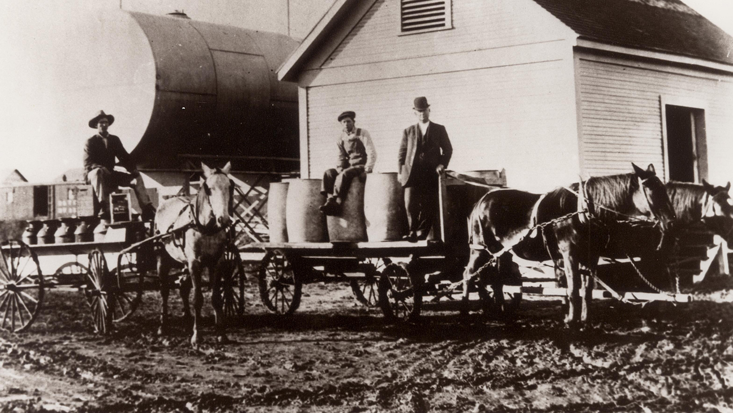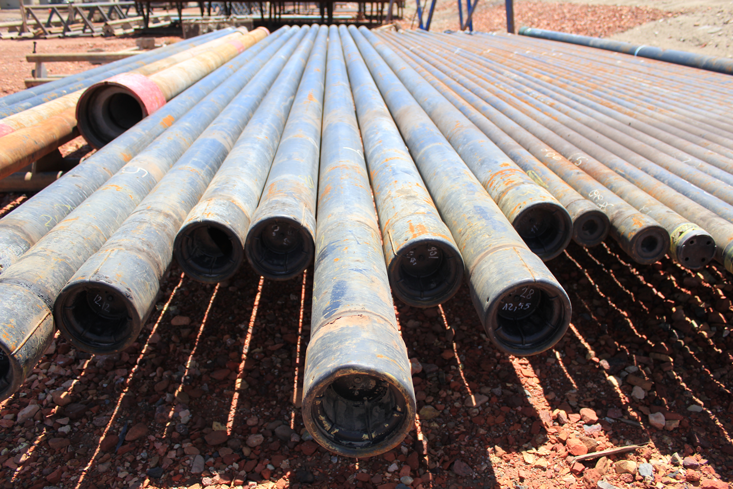Soon after Colonel Edwin Drake struck oil, 70 feet down, in Titusville, Pennsylvania, on Aug. 27, 1859, he had a problem. He had nowhere to store the dark green liquid, and no good way to move it. Until then, locals had collected smaller quantities of oil from seeps and puddles and pits, by wringing it out of saturated wool blankets and scraping it off of wooden boards and collecting it in buckets, and they stored it easily in washtubs and whiskey barrels. But Drake’s well produced 1,000 gallons a day, and subsequent wells produced much more. The nearest railroad was 16 miles to the north, in Corry, just shy of the New York border. The roads there, ill-maintained lumber trails, were barely passable. So, for half a decade, before the Atlantic and Great Western Railroad arrived from the east, and the Allegheny Valley Railroad arrived from Pittsburgh, Drake and the oil men who followed him—finding themselves in possession of so much oil—filled up hundreds of thousands of oak barrels, and delivered them to refineries by horse and by barge. It’s hard to say which method was worse.
Behind teams of horses, men in tall rubber boots hauled one-ton loads of oil—six barrels to the wagon—south 15 miles to Oil City, where the barrels were transferred to barges on the Allegheny river. The men were teamsters. They charged $3 to $4 per barrel, nearly the value of each barrel’s contents. The fluctuating delivery rates depended on the depth of the oily mud the teamsters had to wade through. The teamsters were numerous, and busy; in those early years, 2,000 wagons might cross one Titusville bridge in a day. They were also profane, and demanding. The journalist Ida Tarbell called them tyrants, and plutocrats.
Oil Creek, the local waterway, was insufficient on its own to carry the oil and make the teamsters unnecessary. It needed enhancing. Boatmen did this by damming its tributaries, and loading barrels onto flatboats while they waited. The smallest boats held 20 barrels; the largest 1,000. Every week or so, on “freshet days,” the oilmen opened the flood gates, and sent the oil forth, in exciting but perilous little torrents of water. Twenty-thousand barrels of oil made their way south. Colliding into each other, and the shore, the boats regularly yielded their contents to the water. In a typical freshet, 1,000 or so barrels didn’t survive, but still, locals celebrated gaily. Spilled oil soaked the creek, and lined its banks all the way to the Allegheny River. From there, the surviving oil barrels easily made their way, in bigger barges, down to Pittsburgh.

Whether the oil journeyed by land or by water, the coopers didn’t complain. They were as busy as the teamsters. By 1870, when the region was producing a Drake’s-well-worth of oil every few minutes, one cooperage in Oil City made 1,000 barrels a day. Such shops made pyramids of barrels, as tall as a few horses. Coopers came by the scores. There were more coopers making 42-gallon hooped barrels—each with a distinct company logo on the top—than there were roustabouts (or oil workers).
When the railroad finally arrived in 1862, barrels were loaded onto flat cars, only to slosh around and leak en route. Of each barrel’s 42 gallons, only 40 made the trip. Beginning in 1865, the oil was dumped into specially made wooden tank cars, consisting of 2,000-gallon tubs. The modification made shipping easier, but no less dangerous; a severe fire hazard remained. One old oil man, W.H.H. Fithian, recalled in 1906, “Hardly a day passed but that somebody was not killed or injured” on the railroad. Most oil men, he wrote, called the area “The valley of the shadow of death.” In 1869, big metal cylinders of equivalent volume, with baffles, replaced the wooden tanks, and before long, they doubled in capacity. Still, there was too much oil. “A man with a thousand-barrel well on his hands,” Tarbell wrote, “was in a plight.” Raymond Foss Bacon, in his 1916 treatise, “The American Petroleum Industry,” put it even better: “The magnitude of the petroleum industry made it necessary to find some mode of transportation even cheaper than a railroad.”
The pipeline was just the thing.
The first oil pipeline existed only in imagination. A West Virginian brigadier general named Samuel Karns, who’d worked for the Corps of Engineers, had a salt well in Burning Springs. When it started pumping crude oil, he proposed a 6-inch pipe, 35 miles long, running downhill to the Ohio River at Parkersburg. This was in November of 1860. It was never built. A year later a man from Erie proposed building a wooden pipeline from Titusville to Oil City. It, too, was never built.
A Pennsylvania oilman named J.L. Hutchinson was the first to actually build one, in 1862. It ran over a hill, to a refinery, and worked on the principle of a siphon: as long as the outlet was lower than the inlet, liquid would flow. Except it didn’t work—because the pipe was not airtight. Most people, in fact, thought pumping oil through a long metal pipe was a “visionary scheme,” its funders crazy, the endeavor certain to fail. Stitching together hundreds of pieces of metal, with nary a leak, seemed impossible.
To teamsters, the pipeline promised the termination of their employ. That little tube threatened their entire industry, and they fought it hard.
The next summer, Hutchinson tried again, building a 2-mile line. Although it leaked, the combination of pumps and pipes worked well enough that the Humboldt Mining and Refining Company, to which the line ran, proudly claimed success. Its 1864 prospectus declares: “An oil-duct has been constructed, leading from the Tarr farm to the Humboldt refinery, with power to convey 800 barrels of oil through it in twenty-four hours. … The Company can now pump the oil from Oil Creek over the hills through the iron pipes … at half the expense of former times.” Harper’s reported on the novelty of pumping oil “in tubes.” Hutchinson’s next attempt, though, failed. When he built a 3-mile line the following year, from a well to the railroad, it leaked so much it didn’t matter how powerfully oil was pumped through it.
When Samuel Van Syckel proposed sinking his oil money into a 5-mile pipeline, he was ridiculed. His friends discouraged him, pitied him, and called the idea folly. Strangers made him the butt of their jokes. They’d ask, “Do you intend to put a girdle around the world?” and “Can you make water run uphill?” He was so humiliated that he ate alone, and left by the back door.
A.W. Smiley, who later worked as a timekeeper and paymaster on Van Syckel’s pipeline—which succeeded—attributed the achievement to ingenuity, but also to youthful ambition and self-conceit. Really, though, it was fastidiousness. Another old pipeliner recalled, “it is no longer surprising that so many of the early pipe lines, which had their origin in optimism, ended their careers in bankruptcy. The real surprise is that any escaped the common fate of the many.”
When, in 1865, Van Syckel finished his line, of 2-inch pipe screwed together, from a well to the railroad, it worked. People began to notice. With three Reed & Cogswell single-piston steam pumps, his line was seven times more capacious than Hutchinson’s best. It did the work of 300 teams working 10 hours a day. The Pithole Record called it a “considerable novelty” and later called it “one of the most wonderful of the many wonders.” Tarbell called the day Van Syckel’s pipeline began to run the second most important event in the history of Pennsylvania’s oil region, ranking it just behind the day oil was discovered. She said it began a revolution.
While the first successful—which is to say not astoundingly leaky—pipeline promised oil companies delivery rates of only $1 per barrel, it also promised, to teamsters, the termination of their employ. That little tube threatened their entire industry, and they fought it hard. Having successfully lobbied against the wooden pipeline proposal of 1861, they put up signs around town decrying Van Syckel’s pipe. Then they attacked it with pickaxes. They tied chains to it, and pulled it apart with horses. After the sheriff sent out armed deputies to guard the pipeline, Smiley and his colleagues were “threatened with transportation to a warmer clime.” The teamsters, infuriated with the way things were developing, sent a threatening anonymous letter to the head of an oil company. At 2 a.m., an armed mob of teamsters stormed one company’s tanks, and set five ablaze. Someone telegraphed the governor, asking for help. Van Syckel sent for rifles from New York. The railroaders got mad, too. Employees of the West Penn Railroad Company, sensing a threat from a pipeline that crossed their road, tore it up. The pipe was relaid, and the railroaders destroyed it again.
The pipeline men gave up, and in a nod to the teamsters they’d obviated, settled on transporting oil from the first half of their pipeline, across the railroad tracks in 25-barrel wagons, and into the second half of their pipeline. In this bipartisan fashion, they could do about 8,000 barrels a day. The teamsters eventually left town en masse. Soon enough, pipeline companies raised their prices, minimally undercutting the bids from the bygone teamsters.
The earliest pipelines led from wells to local refineries, and then, as John D. Rockefeller consolidated the refineries, straight to railroads. There were dozens of them, in parallel, supplied by places like the Oil Creek Tube Works. By 1872, the Pennsylvania region’s 1,200 wells were producing 6 million barrels of oil a year, all of it gathered through pipelines. Soon enough, the pipelines began to compete with the railroads, and, taking a cue from Rockefeller, consolidated. Fairview Pipe Line was first to do so. It became the United Pipe Line Association, and eventually part of Standard Oil. By 1874, it had a 4-inch trunk line to Pittsburgh, 60 miles away. In 1875, the Pennsylvania Transportation Company got a charter to build a pipeline clear across the state, to the sea more than 300 miles eastward. First, though, came pipelines to Cleveland. Then Buffalo. At last, New York, Philadelphia, Baltimore. Tide Water, though, beat the Pennsylvania Transportation Company in the race to the Atlantic, completing a 6-inch line from Bradford, Pennsylvania to the Bayonne, New Jersey refineries in 1879. By 1907, the generation following Van Syckel had built enough 6-inch and 8-inch lines to put a girdle around the world, twice.
To achieve these lengths, pipeliners figured out how far and high pumps could push oil. No single pump, or pipe, could possibly get oil across the Alleghenies alone. So they broke long routes into sections, and built storage tanks and pump stations along the way. As links make a chain, so conjoined sections made pipelines. And conjoining sections got easier as pipe manufacturers learned to consistently make good screw-threads.

Laying these 19th-century trunk lines required a big frame and a strong back. The pipe, in 18- or 20-foot sections, was hauled into the woods by horse or ox, on a wagon or sled. The pipe was heavy, as were the tools used to manipulate it. To assemble screw-coupled wrought iron pipe, a foreman banged on the end of the pipe, then another man, bucking it up, rotated it a hair with a huge wrench, called Klein tongs. The tongs were the length of a man, and just as heavy. A bang, a turn—one, then the other. Through the woods, pipeliners buried the line in a ditch. Through wetlands, they encased it in concrete. Long days, and longer weeks, proceeded as such. Neil Mcelwee, the author of a small history, The National Transit Co., Standard Oil’s Great Pipeline Company, said it was like being in the army. “Most pipeline men had an edge, a swagger, an attitude,” Mcelwee writes. “Pipeline men were hardworking, hard drinking rascals on their better days. Farmers liked them but sent their daughters to live with aunts in the city when the pipelines came through.” Another historian, P.C. Boyle, wrote that men accomplished “by sheer force results that now appear astonishing, and at a cost that is little short of appalling.”
After the line was assembled, buried, and filled with oil, linewalkers went out to check for leaks. In long leather coats, and high leather boots—to protect against bites from copperheads and rattlesnakes, which were “as plenty as fleas on a mangy dog”—they hunted for puddles. Discovering one, a linewalker would tap into the parallel telegraph line with a pocket relay, and notify the foreman’s office. Men and tools were requisitioned, and the pipe was dug up and fixed. Hermit-like, linewalkers stayed in sheds along the pipeline. In the spring, many discovered that their pipelines, laid in rivers, had been taken out by floods and ice. They telegraphed for more supplies and men, who waded into frigid water and fixed the pipe. On they went, crossing rivers in rowboats that they tied to shore. In their coat pockets, they carried canned beef, hash, soup. Though they carried walking sticks, and wore hats, their job was not relaxing: If it was determined that a linewalker hadn’t done his job, he could be responsible for the cost of any oil lost.
The shooter, though, had the most dangerous job. Once the torpedo had been filled, and lowered into the bottom of the well, it was his job to make it explode.
The linewalkers were not alone. Carrying brass tools, so as not to make sparks, other men kept rights-of-way clear. Carrying calibrated sticks, gaugers measured and recorded the volume of the oil in storage tanks along the line. Moving oil across the state required volumetric choreography. They checked for water in the oil, and checked the temperature of the oil, adjusting their calculations if necessary. Since these tanks were often hit by lightning, they spent much of their time putting out fires. This they did with wet carpets or sod. If that failed, they used cannon balls, aimed at the bottoms of the tanks. Once drained, a tank could easily be extinguished and repaired.
Every mile or two, inside pump stations, other men conducted the work necessary to keep oil flowing through pipelines. Firemen shoveled coal into the Woodbury & Booth 50-horsepower boilers that ran the pumps. Operators kept the boilers full of water, running at the proper pressure. Laborers maintained and repaired “Long John” engines. Station engineers, trained in hydraulics, supervised. Telegraphers sent messages to district foremen, who sent messages to the main pipeline office. This changed the gathering of news. No longer did the reporter for the Oil City Derrick need to ride his horse from well to well, talking to pumpers and drillers. He could just visit the pipeline office, and wait for the telegraphs to come in.
Because Pennsylvania oil was light (not much wax) and sweet (not much corrosive sulfur), early pipeline operators were not especially troubled by it, at least in a maintenance sense. If necessary, they cleaned their pipelines by pumping canvas rags through them. Though well-intentioned, the efforts worked poorly. By the 1870s, a pipeline scraper—a round squeegee—was devised. Early models had leather cups; by the 1930s the cups were rubber. Pipeliners took to calling these things pigs; before that, they called them go-devils.
The origin of the term relates to another apparatus of the early oil industry. To increase production, men detonated explosives in the bottoms of their wells. The explosive of choice was nitroglycerine, in a container called a torpedo. Colonel E.A.L. Roberts, who patented the process in 1862, torpedoed a “dry hole” in 1866, and got 20 barrels a day. He did it again, and quadrupled his output. More boom meant more oil, or so the thinking went, so where he began with only four quarts of nitroglycerine in narrow tin canisters a foot long, those canisters soon grew beyond 10 feet, capable of holding more than 200 quarts.
The nitroglycerine was delivered to the well in a special wagon, skillfully driven. One man, driving a nitroglycerine wagon over a bump a few inches high, disappeared. His fragments, one writer later suggested, would have fit in a cigar box. The shooter, though, had the most dangerous job. Once the torpedo had been filled, and lowered into the bottom of the well, it was his job to make it explode, by dropping a 10-pound cast-iron projectile onto it. The projectile was a go-devil. Well shooting, oil men wrote, sent shivers from one end of oil country to the other, and nearly blew Bradford, Pennsylvania into Cataraugus County, New York. Hence go-devil: You had to go like the devil when you dropped it.
But for the nitroglycerin, modern pipelines are not so different from the first pipelines schemed up in Pennsylvania. Most are steel, welded together, but iron pipes abound. So do pump stations and storage tanks. Dozens of companies make pipeline pigs, and now they don’t just scrape pipes clean, but (using ultrasonics or magnetic flux) inspect pipes for corrosion damage, too. Through computerized systems, modern operators monitor flow rates and pressure—but the combination of man and machine leaves plenty of room for the same leaks that plagued Hutchinson. That’s why linewalkers continue their work today, some on cars, but many still on foot and horseback.
Now, as then, it’s one thing to build something, and quite another to maintain it.
Jonathan Waldman, a 2017 Alicia Patterson fellow, is working on his second book, Sam, about the development of an unusual robot. His first book, Rust, was a finalist for the Los Angeles Times Book Prize.


























